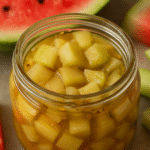Biscuits and Gravy: My Favorite Classic Southern Breakfast Food

I'm not really sure when I developed my fondness for biscuits and gravy, as it was certainly not a regular part of my momma's breakfast repertoire. Now don't get me wrong. My momma was an outstanding country cook, but homemade breads (other than cornbread) was just not something she normally did.
On the other hand, my maternal grandmother made outrageously good biscuits. She would rise every morning before dawn, walk to the barn to milk the cow, and then walk back to the house where she would wake the  family and start her breakfast routine. This always meant scratch-made biscuits, about three-inches across and almost two-inches high, cut out with an old tin can from which both ends had been removed. I still remember how she would blend the Crisco into the mound of flour, baking powder and soda with her fingertips. Then she would make a well in the center, add fresh buttermilk, and gently knead the mixture into a smooth dough. Sometimes she would let me help cut out the biscuits while she carefully placed them in a large pan containing just a little hot grease, making sure she turned each biscuit over to coat each side. This, she contended, helped the biscuits develop a crisp brown top crust while the insides remained light and fluffy.
family and start her breakfast routine. This always meant scratch-made biscuits, about three-inches across and almost two-inches high, cut out with an old tin can from which both ends had been removed. I still remember how she would blend the Crisco into the mound of flour, baking powder and soda with her fingertips. Then she would make a well in the center, add fresh buttermilk, and gently knead the mixture into a smooth dough. Sometimes she would let me help cut out the biscuits while she carefully placed them in a large pan containing just a little hot grease, making sure she turned each biscuit over to coat each side. This, she contended, helped the biscuits develop a crisp brown top crust while the insides remained light and fluffy.
While the biscuits were cooking, she would fry some country sausage and use the drippings to make white cream gravy. Then we would all sit down to a big breakfast of eggs (gathered fresh that morning), sausage, biscuits, and gravy. Leftover biscuits were saved for mid-morning snacking.
While neither biscuits nor gravy actually originated in America, the dish seems to have emerged as a distinctively southern dish in the late 18th century, sometime after the American Revolutionary War. For persons facing a day of laboring in the fields of a farm or plantation, starting with a meal that was both tasty and filling was a necessity. But with food stuffs expensive and in short supply, it also had to be cheap. Thus came biscuits and gravy.
 In the South, pork sausage was both popular and available throughout the eighteenth and nineteenth centuries thanks to the English introducing pigs to Jamestown in 1608. And home cooks, in utilizing all an ingredient had to offer, turned the grease left from cooking the pork into gravy, using flour, water, milk, and pan scrapings. This kind of gravy, seasoned with only salt and black pepper is known by several names including Sawmill Gravy, Logging Gravy, Life Everlasting, and Poor Do, all of which suggest subsistence food for the poor.
In the South, pork sausage was both popular and available throughout the eighteenth and nineteenth centuries thanks to the English introducing pigs to Jamestown in 1608. And home cooks, in utilizing all an ingredient had to offer, turned the grease left from cooking the pork into gravy, using flour, water, milk, and pan scrapings. This kind of gravy, seasoned with only salt and black pepper is known by several names including Sawmill Gravy, Logging Gravy, Life Everlasting, and Poor Do, all of which suggest subsistence food for the poor.
Sawmill gravy (logging gravy) got its name from its association with the Appalachian logging camps of the late 19th century, where crews and their families often survived on little more than coffee, meat, gravy, and biscuits. Also unique to these camps were the "cat head biscuits," so called because of their size and rough exterior, reminiscent of a cat's head.
Other variations of breakfast gravies found served over biscuits include:
? Country, cream, milk, or white gravy - essentially sawmill gravy seasoned only with salt and pepper, without the crumbled sausage bits. This kind of gravy (essentially a Béchamel sauce) is not only good over biscuits, but with chicken fried steak and fried chicken as well.
? Egg gravy - a white gravy made with bacon fat, flour, salt, pepper, and equal parts milk and water, to which a beaten egg is swiftly stirred.
? Chocolate gravy - another variation of cream or milk gravy to which cocoa powder and sometimes sugar has been added.
? Red-eye gravy - usually made from the drippings of pan fried ham which has been deglazed with black coffee. This is another staple of southern cuisine and is sometimes served over grits, as well as biscuits.
? Tomato gravy - white gravy with diced or crushed tomatoes mixed in.
Biscuits too can be prepared in numerous ways. The dough can be rolled or patted flat and cut into rounds. Or, if extra liquid is added to the dough to bring its consistency to that of stiff pancake batter, spoonfuls can be dropped onto the baking sheet, producing "drop biscuits." Another common variation is "cheese biscuits," made by adding grated cheddar cheese to basic biscuit dough.
 Today, one does not need baking skills to enjoy biscuits. There are any number of biscuit mixes available at your local supermarket that require only the addition of water to make dough which you yourself cut, pan, and bake. Also available in the freezer section of your food store is pre-measured frozen biscuit dough, which requires only placing the pucks on a pan and baking. Any of these products will give you an acceptable morning biscuit.
Today, one does not need baking skills to enjoy biscuits. There are any number of biscuit mixes available at your local supermarket that require only the addition of water to make dough which you yourself cut, pan, and bake. Also available in the freezer section of your food store is pre-measured frozen biscuit dough, which requires only placing the pucks on a pan and baking. Any of these products will give you an acceptable morning biscuit.
Far less acceptable, but more convenient, are fresh or frozen pre-baked biscuits that need only be heated for a few seconds in your microwave. These are usually available at some independent bakeries and upper end supermarkets.
 And finally, the abomination of all biscuits--the refrigerated biscuit! Developed and patented in 1931 by Ballard and Ballard, these cylindrical segments of dough encased in a cardboard can may be convenient and even somewhat tasty, but they do not a biscuit make. As much as I hate to admit it, this was my mom and dad's idea of "homemade" biscuits.
And finally, the abomination of all biscuits--the refrigerated biscuit! Developed and patented in 1931 by Ballard and Ballard, these cylindrical segments of dough encased in a cardboard can may be convenient and even somewhat tasty, but they do not a biscuit make. As much as I hate to admit it, this was my mom and dad's idea of "homemade" biscuits.
 I guess all of those times helping grandmother make her fantastic biscuits must have had a positive impact on not only my taste buds but my desire to never again have to eat those store bought cardboard canned biscuits. Today, I make my own buttermilk biscuits totally from scratch. And what's more, they are a golden, crisp, brown on the outside and light and fluffy on the inside. Damn near as good as grandmother's. In fact, writing this story has made me really hungry for-- you guessed it--homemade biscuits and sawmill gravy. So, I'm off to the kitchen to whip up a batch. Wanna join me?
I guess all of those times helping grandmother make her fantastic biscuits must have had a positive impact on not only my taste buds but my desire to never again have to eat those store bought cardboard canned biscuits. Today, I make my own buttermilk biscuits totally from scratch. And what's more, they are a golden, crisp, brown on the outside and light and fluffy on the inside. Damn near as good as grandmother's. In fact, writing this story has made me really hungry for-- you guessed it--homemade biscuits and sawmill gravy. So, I'm off to the kitchen to whip up a batch. Wanna join me?
Try Em: Southern Sausage Gravy, Appalachian Sawmill Gravy, Old Fashioned Buttermilk Biscuits, White Lily Light and Fluffy Biscuits


